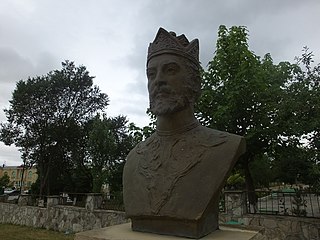Related Research Articles

Ibrahim I was the 33rd Shirvanshah. Because of his cunning politics he managed to remain independent and avoid being deposed by the Turko-Mongol ruler Timur.

Farrukh Yasar was the last independent Shirvanshah of Shirvan (1465–1500). In 1500, the first Safavid ruler, Ismail I, decisively defeated and killed Farrukh Yasar during his conquest of the area. Descendants of Farrukh Yasar continued to rule Shirvan under Safavid suzerainty, until 1538, when Ismail's son and successor Tahmasp I appointed its first Safavid governor, and made it a fully functioning Safavid province.
Hushang, Hooshang, Hoshang or Houshang, is a Persian male given name popular in Iran. It means "of the good choice." It also means intelligence and/or awareness.

The Shirvanshahs were the rulers of Shirvan from 861 to 1538. The first ruling line were the Yazidids, an originally Arab and later Persianized dynasty, who became known as the Kasranids. The second ruling line were the Darbandi, distant relatives of the Yazidids/Kasranids.

Akhsitan I was the 20th Shirvanshah after 1160, and thought to have reigned until the years 1197–1203/04. He was the son and successor of Manuchihr III. His mother was Tamar, a Georgian princess from the Bagrationi dynasty.

The Shirvan province was a province founded by the Safavid Empire on the territory of modern Azerbaijan and Russia (Dagestan) between 1501 and 1736 with its capital in the town of Shamakhi.

Shabaran, was a town and district in the historical region of Shirvan, in what is now the eastern part of Azerbaijan.
Shahrukh was the last Shirvanshah, governing Shirvan under Safavid suzerainty from 1535 to 1538. After persistent disloyalty, the Safavid shah (king) Tahmasp I expelled him, and made Shirvan a full administrative subunit of Safavid Iran. Subsequently, he appointed his brother Alqas Mirza as its governor.
Burhan Ali was a self-declared Shah of Shirvan. He claimed to be son of Khalilullah II.
Mehrab Mirza was the self-declared Shah of Shirvan after the death of Burhan Ali.
Gurban was the self-declared Shah of Shirvan after the downfall of Mehrab of Shirvan.
Qasem Mirza was the self-declared Shah of Shirvan after the death of Gurban Ali.
Abu Bakr Mirza was the final self-declared Shah of Shirvan after the downfall of Kavus Mirza.
Sheikh Bahlul Darbandi was a member of the House of Shirvanshah, the ruling dynasty of Shirvan. He was a grandson of Shirvanshah Keykubad I, brother of Shirvanshah Ibrahim, and cousin of Shirvanshah Kavus.
House of Derbent or Darbandids was a younger branch of Shirvanshahs that succeeded Kasranids.

The conquest of Shirvan was the first campaign of Ismail, the leader of the Safavid order. In late 1500, Ismail marched into Shirvan, and, despite heavily outnumbered, decisively defeated the then incumbent Shirvanshah Farrukh Yassar in a pitched battle, in which the latter and his entire army were killed. The conquest resulted in the toppling of the Shirvanshahs as autonomous rulers, who had ruled large parts of the Caucasus for centuries, and the incorporation of their domain.
Mirza Ata-Allah Isfahani was a high-ranking Persian statesman in the early Safavid era, who served as the vizier of Azerbaijan, Qarabagh, and Shirvan.
Galeyi Beygurt, also known as Galey-Bughurt or simply Bughurt fortress is a historic monument located 20 km north-east of the center of Shamakhi city.
Badr Shirvani was a Persian poet. He spent most of his career at the court of the Shirvanshahs, but received patronage from other rulers as well.
The High Middle Ages, or Classic Feudalism Period in what constitutes the present-day Republic of Azerbaijan, lasted from around the 11th century to the 15th century AD. The High Middle Ages were preceded by the Early Middle Ages and were followed by the Late Middle Ages, which ended around the 15thcentury AD. Key historical trends of the High Middle Ages include the incorporation of the territories that constitute present-day Azerbaijan into the Seljuk Empire, the establishment of the Eldiguzids, the Mongol invasions and the rule of the Ilkhanate, the invasions of Timur and the establishment of the Turkoman Kara Koyunlu and Aq Qoyunlu tribal confederations.
References
- ↑ Sara Ashurbayli. History of Shirvanshahs. p.248